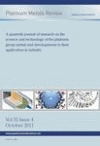-
oa Electrochemical Destruction of Organic Hazardous Wastes
The Cerium Oxidation Cerox™ Process Electrochemical Cell
- Source: Platinum Metals Review, Volume 46, Issue 1, Jan 2002, p. 18 - 23
-
- 01 Jan 2002
Abstract
The destruction of hazardous organic waste produced as waste products in chemical processes has become an industry in itself, regulated by environmental agencies and government bodies. The environmentally harmful waste has been incinerated at high temperature with the aim of forming less harmful and less complex compounds, but this may lead to dioxin formation in the presence of chlorine-containing waste. It may also be treated electrochemically to result in carbon dioxide and water. One on-site electrochemical method, described here, which uses platinum-plated titanium electrodes, can treat most organic waste materials very effectively at low temperatures.
© Johnson Matthey


